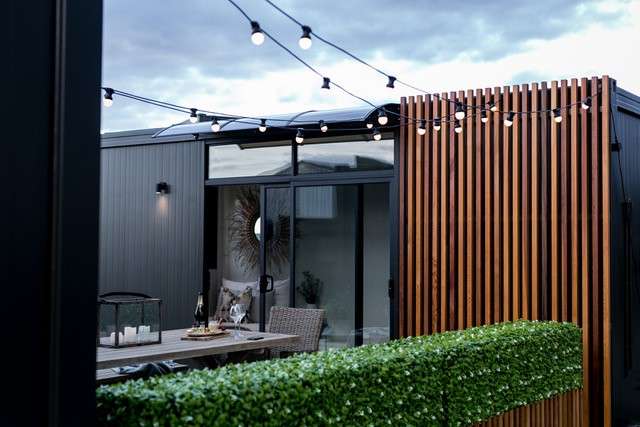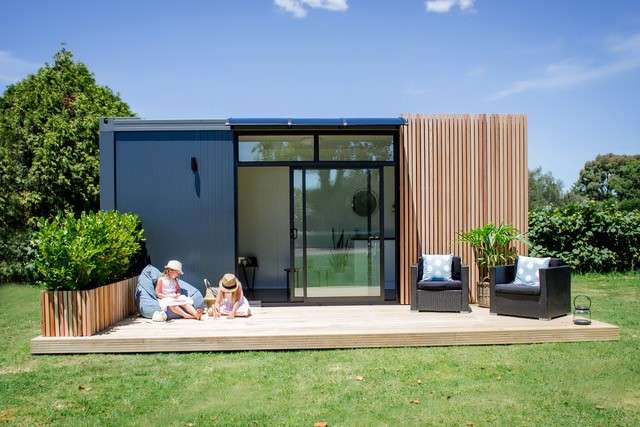If the crowds milling through the street of tiny homes at the recent Auckland Home Show are anything to go by, many Kiwis are in love with the idea of tiny homes.
One of the earliest tiny house Instagram feeds, @tinyhouse, is now ten years old, with over 730,000 followers (and a book just out), showcasing petite perfection from around the world.
But is the tiny trend going large with numbers of people actually living in them, not just fantasising?
Ahna Brownlee, of Whakatane-based Podlife now in its fourth year of production, says that it is hard to gauge just how many of the company’s pods are actually used for genuine tiny house living rather than as sleep outs on existing properties.
Start your property search
Brownlee would guess now that around half of enquiries are for people who are genuinely after full tiny house living. Many, she says, have been dreaming and plotting about downsizing for the three or more years since they first encountered Podlife, and are only now finally ready to start living small. Most have their own land.

Whakatane-based Podlife has been shipping tiny homes, up to 15 sq m, around the country since 2016. Picture/supplied
“We were doing small living before small living was a thing, it wasn’t such a big movement then,” says Brownlee. “It was more a convenience for adding a sleep out on site for teenagers, or on farms for workers.”
Heartening for Brownlee and builder husband James are the number of enquiries from first home buyers, often accompanied by parents keen to get their kids started on the housing ladder. The most touching, Brownlee says, are the older people who’ve been renting all their lives and can see that owning a house, albeit tiny, is finally within their reach.
The couple had experimented with building a couple of tiny house builds back in 2013 out of their shed building factory, launching Podlife in 2016 after they sold that company. Demand has is grown so much that the company, which employs not only builders, but also specialist trades like plumbers and sparkies, is about to move to bigger premises so they can double output. They’re also testing bigger two-bedroom pods that they hope to have in production by the end of the year to meet the demand for permanent housing.
Takanini-based builder Gavin Barr launched his Ecospace pods at the Home Show, after playing with the idea of sustainable off-the-grid housing as an apprentice. He used his day job building regular houses to fund the start-up, aiming to fill the gap in affordable housing.
He reckons some 40,000 people checked out the tiny house street during the show, and now has plenty of serious enquiries to follow up on.
But many of the enquiries were for people looking to add accommodation to their bach, or create an Air BnB, rather than permanent homes.
He was gratified that millennials or boomer/downsizers wanted to try the tiny life, permanently, but heard that finding land where a tiny home, either fixed or on wheels, is allowed is the barrier. Barr was told Northland or Coromandel, rather than big cities, were more receptive. He also spotted a niche of developers keen to create campground cabins, or eco-tourism businesses.
“I’m a nature lover, I love surfing, I wanted to reduce our footprint on the land,” says Barr. “Tiny is affordable, you have the freedom of not being fixed to one property, and it’s a more sustainable lifestyle.”
Brownlee too has heard the social media chatter that the biggest barrier to owning a tiny home is land. Most of Podlife’s customers have arrangements to park their house on family members’ properties, but there are also New Zealand web sites for strangers seeking land to rent. Some families are planning extended family living, linking up series of pods with decks and outdoor living.

A Podlife tiny house. Picture/supplied.
The company, which has shipped pods around the country from Kaitaia to Queenstown, is careful to meet both building compliance codes for Whakatane District Council, where they are based, and with building and other consents at the receiving council, producing site and foundation plans for local builders for utility hook up. Even for pods which owners are planning to keep on wheels (thus coming under land transport, rather than building, regulations), the Brownlees are careful to make sure they’re complying with district planning rules.
And yes, Brownlee laughs, she would love to live in a pod herself – warm, insulated, double glazed – rather than their old, draughty villa.
Barr’s Ecospace production process, using insulated panels (SIPs), eco finishes on cladding and interiors, and minimizing build waste is sustainable. Right now he’s living above the factory, but he and his partner plan to go tiny next year when the business moves to a bigger factory and they can find land to go off grid and live sustainably.
This is not news to Nathan Orr, who, after years exploring the tiny house world, is one of the founding members of the New Zealand Tiny House Association. Set up to provide information on building and living in tiny houses, the nascent organisation is still in the process of figuring out how to work with government agencies, local councils and other development organisations.
While their website suggests the concept of tiny usually refers to dwellings that are less than 37 square metres, and can be either fixed to the land or built on a trailer, Orr says that it is still too early to narrow down the broad definitions.
“We need to understand the difference, and clarify what this space means,” he says. “We haven’t set a minimum or a maximum; it’s not as clear cut as what most people think.”
While complying with the Building Act, with regulations about site coverage and set back on land for tiny houses are a given, Orr was not prepared to comment on discussions about land availability. But the drivers for the appeal of tiny houses are the same worldwide.
“Nationwide, housing is a crisis in New Zealand, and access is a barrier, the cost of buying land, availability,” he says. “There’s a growing interest in [tiny house] for reasons of affordability, for a more sustainable way of building using less resource.
“If you build smaller, you can afford to build better, you use far less energy. A smaller space is changing your impact on the environment.”
The organisation is yet to gather numbers on the number of factory build companies supplying the market, but says the new industry has developed significantly over the last couple of years.
But there are tiny house sceptics. Even though he successfully auctioned a container converted to a tiny home this summer, Napier Tremains’ real estate agent Leon Dear sees interest only from people interested for baches or Airbnb, not permanent use.
While the auction achieved $120,000 for the charity Look Good Feel Better, Dear says most people’s reaction – including his own – was “who can live in those little houses?”
Architects & Interiors designer Melissa Burne, who designed the container conversion, says that while she’s a fan of keeping house foot prints smaller to keep costs down, she personally couldn’t imagine living in one either.
“The cost of building has gone up, so people can’t afford big houses any more with space for two living rooms, a spare room, a scullery,” she says. “You can be a bit clever with design, we did a two bedroom home of 80 sq m recently.”
She sees the trend being more about fitting secondary dwellings on an under-used site, to increase density in towns where subdividing is not an option.










































































